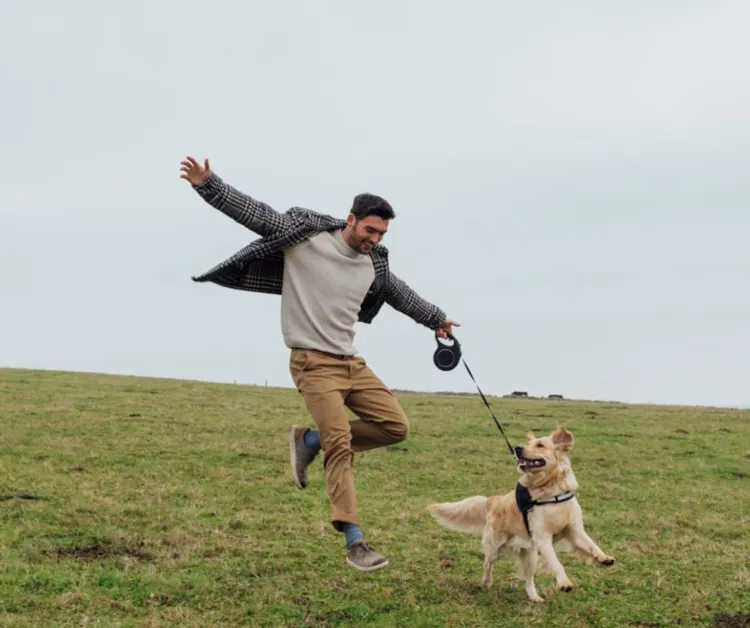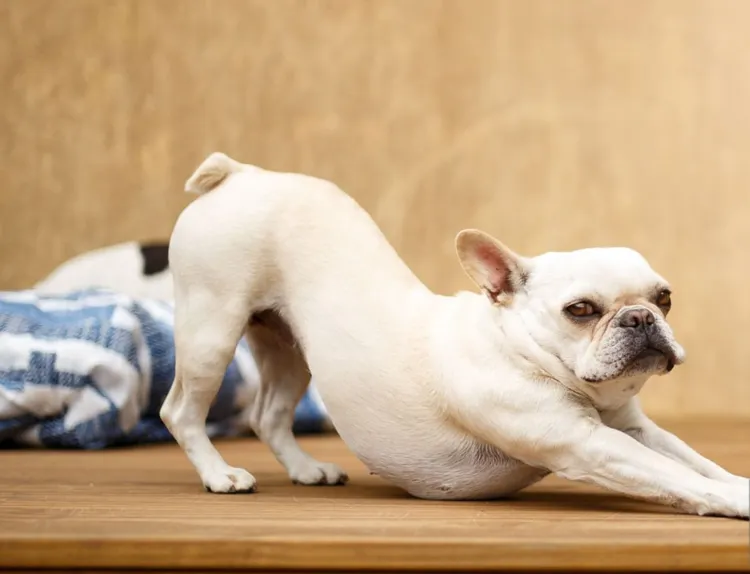Ever noticed your dog doing a long, lazy stretch after waking up? While it might seem like a casual, sleepy movement, there’s a lot more going on beneath the surface. Dogs stretch for various reasons—from warming up their muscles to relieving stress, to communicating with other dogs and humans. Understanding why your dog stretches and what different stretches may indicate can provide you with valuable insight into their physical and emotional health. In this post, we’ll explore why dogs stretch, the benefits of this behavior, when it could signal a health concern, and eco-friendly ways to support your dog’s overall well-being.
Why Do Dogs Stretch?
Dogs stretch for multiple reasons, and each serves an important function. Let’s break down some of the most common reasons behind this behavior.
1. Muscle Warm-Up
Much like humans, dogs stretch to warm up their muscles after periods of rest. When dogs sleep or lounge for extended periods, their muscles are in a relaxed state. Stretching helps re-engage those muscles, preparing them for physical activity.
- Physical Health: Stretching helps increase blood flow to muscles and joints, which is crucial for mobility, flexibility, and overall physical health. It prevents stiffness, reduces the risk of injury, and maintains the dog’s range of motion.
Expert Insight: Dogs have a natural instinct to stretch upon waking, much like humans do when they rise. This “morning stretch” helps re-activate muscles, ensuring that they’re limber and ready for movement.
2. Stress Relief
Stretching is also a natural way for dogs to relieve tension and anxiety. Similar to how people stretch when they’re feeling tense, dogs may engage in this behavior to reduce physical and emotional stress.
- Relaxation: Stretching helps release built-up tension in the body. In stressful situations—such as a visit to the vet or meeting new dogs—your pet might stretch to release that anxiety.
Eco-Conscious Practice: Encourage stress-relieving stretches for your dog by providing calming environments that incorporate eco-friendly, pet-safe materials. You can create a quiet, green space for your dog using non-toxic, natural products.
3. Communication
Sometimes, dogs use stretching as a form of communication. A friendly stretch, followed by a wagging tail, can signal relaxation and contentment. It’s their way of saying they’re comfortable and feel safe in their surroundings.
- Social Signaling: Dogs often stretch as part of their body language when interacting with other dogs or humans. If your dog stretches when greeting you, it could be their way of saying “hello” in a non-threatening manner.
4. Instinctual Behavior
Stretching is an instinctual behavior that dogs have inherited from their ancestors. Wolves, for example, often stretch before engaging in activities like hunting or playing. This stretching behavior helps maintain muscle readiness and flexibility, essential for survival in the wild.
- Mobility: For wild animals, staying limber ensures readiness for immediate action, whether it’s chasing prey or escaping predators. Though your dog doesn’t need to hunt, this instinct remains.
5. Attention-Seeking
If your dog stretches while gazing at you or right before engaging in play, it might be an attempt to get your attention. Some dogs have learned that stretching gets a positive reaction from their owners—whether it’s a pat on the head, a belly rub, or an invitation to play.
Tip: If your dog often stretches as a form of attention-seeking behavior, it’s essential to ensure that they are receiving enough daily exercise and mental stimulation.
When Stretching Indicates a Health Concern
While stretching is generally a healthy and beneficial behavior, there are times when it might signal something more serious.

1. Excessive Stretching
If your dog is stretching excessively—especially in ways that seem unnatural—it could indicate discomfort or abdominal pain. Dogs may stretch frequently to relieve pressure from gastrointestinal discomfort caused by issues like bloating or indigestion.
- Signs to Watch: Look for other symptoms like a bloated stomach, lethargy, or repeated attempts to vomit. If your dog exhibits these signs, a vet visit is necessary.
2. Arched Back Stretches
If your dog stretches with an overly arched back (often referred to as the “praying position”), it could indicate a back injury, muscle strain, or even pancreatitis. This posture, particularly when combined with other signs like whining or refusal to eat, might be your dog’s way of relieving pain.
- When to Be Concerned: If your dog frequently assumes this position or if the behavior occurs suddenly, it’s crucial to consult a vet. It could point to more serious issues such as spinal problems or gastrointestinal pain.
3. Frequent Stretching Post-Exercise
While some stretching after exercise is normal, excessive stretching after physical activity might suggest stiffness or joint pain. This could be a sign of arthritis or joint issues, especially in senior dogs.
- Action: Monitor how often your dog stretches after exercise. If it seems excessive, consult with your vet to rule out any joint problems or arthritis.
4. Increased Stretching in Senior Dogs
Senior dogs may stretch more frequently due to age-related issues like hip dysplasia or arthritis. These conditions cause joint pain and stiffness, which makes stretching a way to relieve discomfort.
Prevention Tip: Incorporate eco-conscious joint supplements into your dog’s diet, and ensure they receive regular low-impact exercise like swimming or walking to maintain joint health.
How to Encourage Healthy Stretching
Promoting healthy stretching behaviors in your dog can help keep them active, flexible, and stress-free. Here are some eco-friendly ways to encourage healthy stretching:

1. Daily Walks and Playtime
Regular physical activity is essential for keeping your dog limber and promoting healthy muscle function. Incorporating daily walks and playtime not only provides exercise but also encourages natural stretching throughout the day.
- Eco-Friendly Tip: Use sustainable, eco-friendly leashes and harnesses made from recycled materials to reduce your carbon footprint during your dog’s walk.
2. Canine Yoga (Doga)
“Doga,” or dog yoga, is a fantastic way to incorporate gentle stretches into your dog’s routine. This bonding experience allows you to guide your dog through light stretching exercises that promote relaxation and flexibility.
- Benefits: Doga encourages healthy stretching and improves muscle strength and joint flexibility while offering mental relaxation for both you and your dog.
- Eco-Conscious Tip: Use sustainable yoga mats made from natural materials like cork or recycled rubber. Choose eco-friendly toys to engage your dog in interactive stretches during playtime.
3. Monitor Posture and Behavior
Keep an eye on your dog’s posture and how they stretch. Changes in stretching behavior can be an early indicator of underlying health issues. Regularly checking their stretching patterns ensures you can address potential problems early on.
- Health Monitoring: If you notice changes, such as increased or decreased stretching, consult your vet to rule out any health concerns.
Conclusion
Stretching is much more than just a quirky behavior for dogs—it’s a vital part of their physical and emotional health. From warming up muscles to relieving stress, stretching plays a key role in keeping your dog limber, happy, and healthy. However, some types of stretching can also signal underlying health concerns, so it’s important to monitor your dog’s behavior closely.
By encouraging regular exercise, incorporating eco-conscious practices like canine yoga, and using sustainable pet products, you can support your dog’s overall well-being in a way that’s good for both them and the planet. Small changes, like opting for natural supplements and sustainable toys, can go a long way in promoting a healthy lifestyle for your furry friend.



